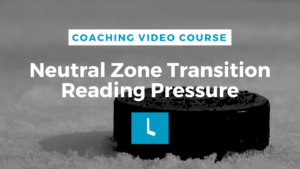(Transcribed from How to Play Hockey: Our Minor Hockey Coaching Course.)
As we talked about in previous videos of forcing a player to the outside or protecting the middle of the ice and protecting the “fort”, this idea of forcing from the inside out is really important. Inside of the ice, being in the middle, both sides being along the boards was also discussed in the previous video. Let’s take these examples…
[maxbutton id=”2″ ]
Example #1:
- A FWD from the offensive team is attacking against the D. Let’s say these two players are perfectly aligned with each other coming down the ice. The attacking FWD’s right shoulder is in line with the D’s left shoulder and his/her left shoulder is in line with the D’s right shoulder. If we are aligned like this then the attacking FWD has an equal chance of going right or going left on this D. We as a defender dont want to give this FWD both of those options.
- For the D to play this attacking FWD inside out, he/she needs to move into the middle of the ice a little more and align his/her outside shoulder with the FWD’s inside shoulder.
- By doing this as a D you allow the FWD to see the extra bit of space along the outside and usually he/she will then attack along the wall, wide. This is what you want.
- So by taking away the middle of the ice this D can then entice or allow this FWD to go to the outside and then pursue by angling.
- This D will try to maintain skating backwards in line with the near side post to play that one-on-one.
- But if this FWD has good speed and gets about even with the body of the D, then this D may have to pivot to forwards in pursuit to try to get a good angle to keep the FWD wide. While always remembering to maintain a good stick on puck throughout the process.
The major point to get across here is that we always want to try and take away the middle of the ice, give the outside and was the attacking team does so, then take it away!
Example #2:
- Let’s say we’re truly attacking against the opposing net now and the other team’s D1 has got the puck towards the corner on the goalies glove side.
- We don’t want to allow this defender to be able to get behind the net and use it as a shield for his/her advantage in pursuit of a clean and easy break out.
- So we want to try to force from the inside out.
- Our F1, the forechecker in pursuit, would try to come from the weak side of the ice with his/her body and stick taking away that lane as any option for the opposing D1.
- By doing this and taking away that option we a slowly forcing that D1 up the strong side of the ice which is usually clogged up with bodies and where we have our F2 waiting.
- Once our F1 has been able to force the D1 up the wall now our F2 who is waiting can react and attack the D1 with good pressure and forecheck. All the while we have our own D1 strong side ready for a loose puck our F3 supporting high middle lane and our D2 has backed up off the blue line to support.
It all comes down to body positioning and dictating where we want the puck carrier to go. Start on the inside they’ll be more likely to then go to the outside where we can use the boards to pressure and force. And that’s checking from the inside out!
I’ll see you in the next video.
Looking to download half ice hockey practice plans, goalie drills for teams (not a goalie coach?!) or small area games drills? We’ve got you covered too. Click here. Perfect for recreational level coaches.





